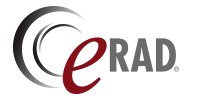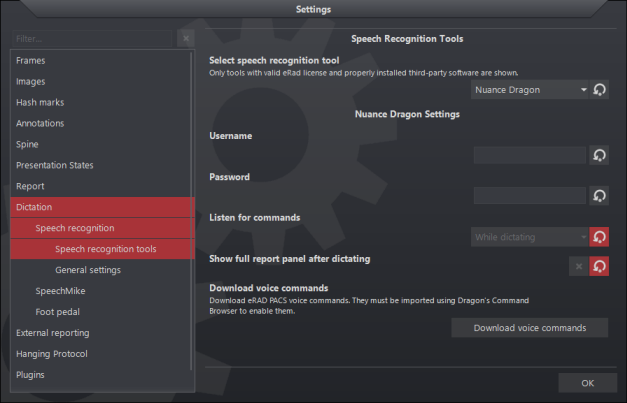 PACS
Desktop Viewer
PACS
Desktop Viewer
 PACS
Desktop Viewer
PACS
Desktop Viewer
Speech Recognition and External Reporting Systems
Speech recognition (SR) converts spoken language into edit-able text without manual transcription. Instead of using a keyboard to type text into an editor package, the user talks and the words appear in the text area. The converted text has the same properties as text entered manually. Optional embedded SR support is provided, in which the SR tools are integrated into the viewer's basic reporting function. For users running an integrated reporting application on the workstation, an optional interface is included to use as an alternative to its embedded solution.

Nuance Dragon Naturally Speaking
The Embedded Dragon Naturally Speaking package is provided as an optional plug-in module. It requires a plug-in module license and a licensed copy of Dragon Medical Practice Edition 4 installed on each workstation.
Workstation requirements are as follows:
The embedded SR package is intended to be used with a Philips SpeechMike. Other microphones are supported, but the integrated controls are only available on the SpeechMike.
To configure the viewer to use embedded SR:

When using SR, it is possible to retain a copy of the WAV file created when dictating the report which is unnecessary if the user is responsible for editing the resulting text. However, if the results of the SR processing need editing by a third party, such as by a transcriptionist, save the original recording for validation. Check the box labeled Auto record WAV when dictating in the Settings panel under the Dictation/General Settings panel to save the WAV file.
eRAD PACS has integrated a set of voice commands specific to the features available in the viewer. These commands must be downloaded from the eRAD PACS server and uploaded into the Dragon vocabulary.
The available viewer specific commands are given in the following table:
| Voice Command | Description | Comments |
| approve | Approve a report and set state to Final | |
| bold font | Set Selected text to bold font | Applies to selected text only |
| close study | Close the current study | |
| close views | Close the image views | |
| compact report panel | Display the compact report panel | |
| customize settings | Open Customize Settings window | |
| end dictation | End the dictation and disable the microphone | |
| end study | End the current viewer session | |
| exit from viewer | Close the study and the viewer | |
| fit image | Set image zoom to fit-to-window | Requires a selected image frame |
| focus to addendum | impression | note | observation | Set cursor focus to the report’s Addendum, Impression, Note or Observation field | Available with the full report panel is open |
| full report | Display the full report panel | |
| full screen | Display selected image in Full Screen mode | Requires a selected image frame |
| help contents | Pop up the Help window | |
| hide report panel | Close the compact or full report panel | |
| invert image | Invert the selected image’s greyscale setting | Requires a selected image frame |
| italic font | Set selected text to italics font | Applies to selected text only |
| layout manager | Display the layout manager | |
| next frame | Scroll to the next image | Requires a selected image frame |
| OK | Select the OK button | Available when the close prompt notice is displayed |
| open next study | Open the next study on the worklist | |
| open previous study | Open the previous study on the worklist | |
| overlays | Show/hide overlays | |
| play cine | Start recursive cine mode | Requires a selected image frame |
| previous frame | Scroll to the previous image | Requires a selected image frame |
| record | Start recording dictation | |
| record stop | Stop recording dictation | |
| report templates | Set focus to the report templates toolbar | Available if the full report panel is open and it has the report templates toolbar displayed |
| reset image size | orientation | position | Reset the selected image’s size, orientation, or position | Requires a selected image frame |
| reset window level | Reset the selected image’s window/level setting | Requires a selected image frame |
| send report | Send the report to the server | |
| set state read | dictated | preliminary | final | Set the study state to Read, Dictated, Preliminary or Final |
|
| show hash marks | Display hash marks on all images | |
| show localizers | Display localizer lines on all images | |
| show report panel | Display the default report panel | |
| stop cine | Stop recursive cine mode | Requires a selected image frame |
| underline font | Set the selected text to underline font | Applies to selected text only |
To download the commands:

Many speech recognition and reporting systems provide an interface to pass control between a PACS viewer and the client application. The interface consists of an XML file written to the local file system by the viewer and picked up by the speech recognition system. The XML file contains study details, user IDs and other information.
External reporting systems configured into the system by default include the following:
The list of external reporting systems is configurable. If the system is not displayed, the system administrator must add.
To configure the viewer to use an external reporting system as the default reporting solution, the eRAD PACS XML Interface Speech Recognition plug-in module must be licensed, the user must have permissions to load the plug-in module, and the report application’s client plus interface module, if necessary, must be installed and running on the workstation.
Set the dictation mode as follows:
The interface allows for creating an XML file when the viewer session opens in addition to when starting to record a report. Multiple Open and Record events can be assigned to integrated report system engines. Additionally, both events allow creating a second XML file when an end event occurs. End events happen only if the corresponding on event occurred.
| Event | On Event | Off Event |
| Open | Viewer session initiated or restored from a bookmarked state | Study is closed or bookmarked, or the viewer session is terminated |
| Record | User presses the Record button for the first time after the viewer session started or is restored from a bookmarked state | The study is closed or bookmarked or the viewer session is terminated. Occurs only if the On Event occurred |
The XML file created for a trigger event is defined in the configuration files specified in the Speech Recognition Engine Configuration Manual. The record event occurs by clicking the Record button in the EP viewer’s Audio toolbar after each trigger event in which study details are written to the configured XML file. The reporting system detects the file, reads its contents, removes the XML file and then takes over the reporting process. Consult the reporting system’s user manual for information on its operation.
Mouse and keyboard control generally remain with the eRAD PACS viewer, unless reporting system’s user interface is displayed and given the mouse and keyboard focus. The report created by the external reporting system does not appear in the viewer’s report panel immediately. The system sends the report to eRAD PACS server directly or through the RIS. The information written to the XML file passed from eRAD PACS to the external reporting system is configurable. Refer to the eRAD PACS Speech Recognition Configuration Manual for details.